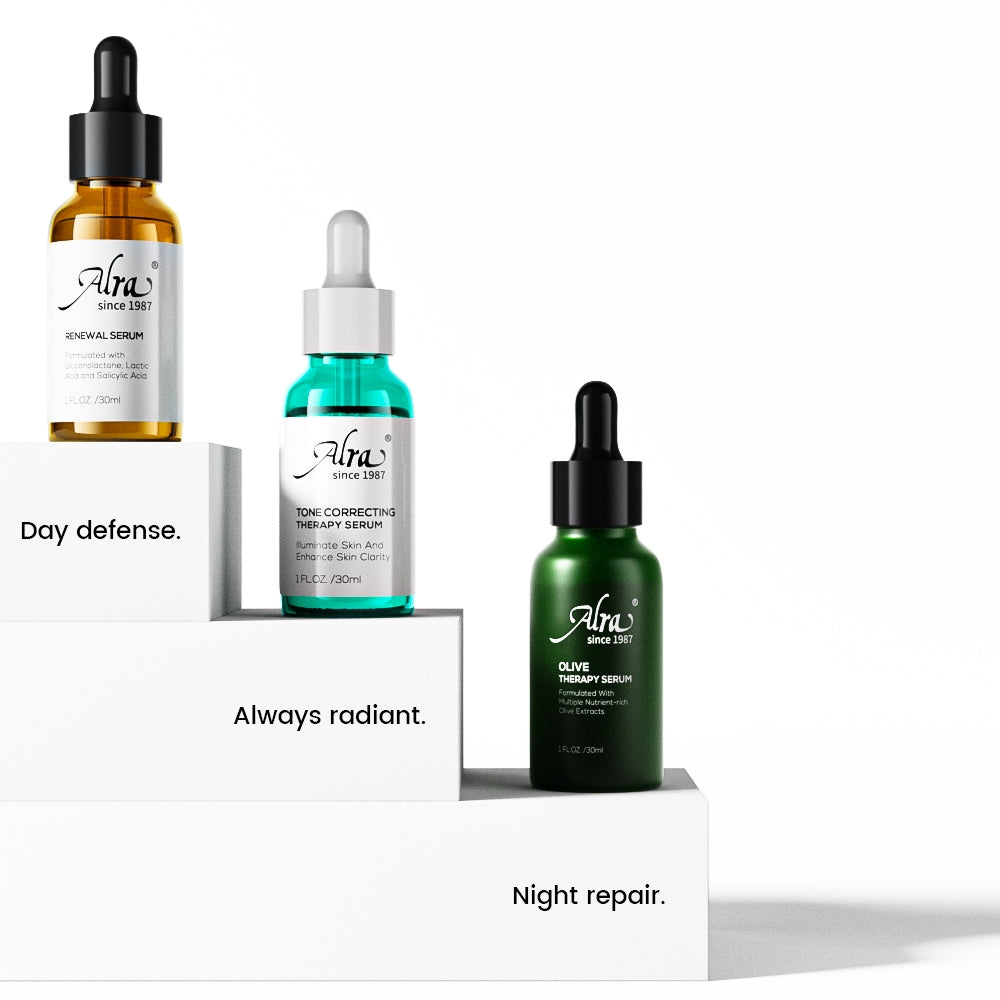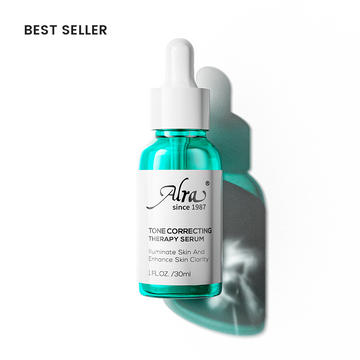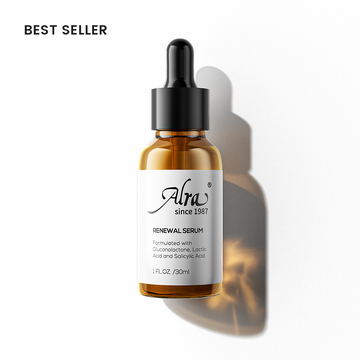When it comes to caring for your skin, timing is everything. If you’ve ever wondered why there are separate products for morning and night, you’re not alone. The truth is our skin behaves differently during the day versus at night, and its needs change accordingly.
By understanding these differences, especially for those of us in our 30s, 40s, 50s and beyond, we can fine-tune our routines to keep skin healthy, glowing, and youthful. In this post, we’ll break down what your skin needs at each time of day, from ingredients to routine steps, and back it up with science so you can confidently correct and elevate your skincare routine.
Skin by Day vs. Skin by Night: Why Timing Matters
During the day, your skin’s primary job is
protection. It acts as a shield against UV radiation, pollution, and other environmental stressors you'll encounter from morning until evening. At night, however, the focus shifts to
repair and your skin works to fix damage (like DNA damage from UV exposure) incurred during the day. This
day-night difference is driven by your body’s circadian rhythm, which affects skin functions like cell renewal, barrier strength, and hydration levels.
What does this mean for your skincare? In the morning, you want to arm your skin to prevent damage (think antioxidants and sunscreen). Come nighttime, you’ll want to treat and restore your skin (think exfoliation, retinoids, deep hydration). Dermatologists recommend using protective antioxidants in the AM and reparative actives like retinol in the PM, not only due to effectiveness but also because some ingredients (like retinol) make skin sun-sensitive. In short, use your vitamin C and defensive products in the morning, and save the heavy hitters for night.
A targeted trio of serums can cover your skin’s 24-hour needs: a Renewal Serum for gentle exfoliation, a Tone Correcting Serum for brightening, and an Olive Therapy Serum for antioxidant repair. Incorporating a set like this ensures your skin gets protection by day and rejuvenation by night, keeping it healthy and radiant.
Now, let's dive into the specifics of an ideal morning routine versus a nighttime routine, and how you can give your skin exactly what it needs at each phase of the day.
Morning Skincare: Protect and Prevent
Your morning skincare routine should be all about shielding your skin from the day’s assaults and preventing premature aging. This is especially crucial as you enter your 30s and beyond, when years of cumulative sun exposure and environmental stress can start to show up as fine lines, pigmentation, and dullness. A simple yet effective AM routine might include the following steps:
-
Gentle Cleanse: Start by cleansing your face to remove any sweat or oil built up overnight. Use a mild cleanser that doesn’t strip your skin. (If you have very dry skin, you can even just splash with water in the morning.) Clean skin preps your face to better absorb the protective products that come next.
-
Antioxidant Serum: After patting your face dry, apply an antioxidant-rich serum. Antioxidants are your morning shield, they neutralize free radicals from UV rays and pollution that would otherwise break down collagen and cause oxidative damage. For example, a vitamin C serum in the morning can help protect skin cells from DNA damage due to sun exposure. Ingredients like vitamin C, vitamin E, green tea, or resveratrol scavenge those aging free radicals. One great option is a serum with olive leaf extract, 20x more potent than VC; olive extract has significant anti-inflammatory and antioxidant properties. This means it not only guards your skin’s collagen from free-radical attack but also soothes redness and irritation. (Tip: Gently press the serum into your skin and give it a minute to absorb.)
-
Moisturizer: Next, apply a lightweight moisturizer (ideally with hyaluronic acid or glycerin) to hydrate and plump the skin. In your 30–60s, skin tends to be drier as sebum production decrease, so don’t skip this even if you didn’t in your younger years. A good moisturizer will seal in your serum and fortify the skin barrier, which helps your skin stay resilient against irritants and prevents dehydration through the day. If you have oily or combination skin, opt for an oil-free gel moisturizer in the morning; drier skin types may prefer a cream.
-
Sunscreen (SPF): Never let your morning go without sunscreen because it’s arguably the most important step for preventing aging and skin cancer. Use a broad-spectrum sunscreen (SPF 30 or higher) as the last step in your AM routine. Make sure to cover all exposed areas (face, neck, even the backs of your hands). Daily sunscreen use has been proven to significantly slow signs of skin aging compared to occasional use. In fact, studies found that people who applied SPF daily had noticeably younger-looking skin (with fewer wrinkles and age spots) than those who didn’t. Sunscreen is your daytime armor: it prevents UV rays from generating free radicals and breaking down collagen and elastin in your skin. For added benefit, many modern sunscreens also contain antioxidants or soothing ingredients, but regardless, consistency is key. (Yes, even on cloudy days and in winter!)
Morning Routine in Action: After cleansing, you might apply a few drops of an Alra Olive Therapy Serum to load your skin with antioxidants and calm any morning redness. Layer on a Alra Tone Correcting Serum (if uneven tone or dark spots are a concern) to brighten your complexion.
This combo gives you a dose of vitamin C, niacinamide, and other actives to start the day with a glow. Follow up with your moisturizer and finish by generously applying sunscreen. Now your skin is hydrated, defended, and ready to face the day’s challenges.
Night Skincare: Repair and Rejuvenate
While your morning routine was about defense, your nighttime routine is all about offense, giving your skin the treatments it needs to repair itself and correcting any issues. In your 30s-60s, nighttime skincare is the perfect time to address concerns like fine lines, pigmentation, and loss of firmness that develop over time. At night, your skin is in regeneration mode and also more receptive to products (skin permeability actually increases in the evening), so this is when those powerful ingredients can penetrate deeply. Here are the key steps for PM:
-
Thorough Cleansing: Always cleanse at night, especially to remove the day’s buildup of sunscreen, makeup, oil, and pollutants. Going to bed without washing your face is a big no-no as it can lead to clogged pores, dullness, and even accelerate aging due to lingering free radicals. If you wear makeup or heavy SPF, consider double cleansing: first use a cleansing oil or balm to dissolve stubborn sunscreen and makeup, then follow with a gentle water-based cleanser to clean residue. This two-step cleanse ensures you start with a fresh canvas. Clean skin will better absorb the expensive serums and creams you’re about to apply.
-
Treatment Serum (Exfoliate or Retinol): Night is the ideal time for your most potent treatment products, such as chemical exfoliants or retinoids, which truly transform the skin. After cleansing (and while your skin is mostly dry), apply your active serum. Two gold-standard options are:
-
Retinoids (Vitamin A derivatives): Retinol and its prescription cousins (like tretinoin) are famous for their anti-aging prowess. They increase cell turnover and boost collagen production to smooth wrinkles. In fact, retinoids have the most evidence for reducing fine lines. They literally reduce wrinkles by increasing collagen in the skin. They also help fade dark spots and improve skin texture over time. Because retinoids can make your skin more sun-sensitive, they are best used at night. Start with a pea-sized amount, and if you’re new to retinol, use it 2-3 times a week, gradually working up to nightly as tolerated (this helps minimize irritation).
-
Chemical Exfoliants: If retinol is too strong or you are targeting dullness and clogged pores, an exfoliating serum with AHAs (like glycolic or lactic acid) or gentler PHAs can be used. These acids dissolve the “glue” between dead skin cells, helping to slough off the dull top layer and reveal fresher skin beneath. For example, a Alra Renewal Serum formulated with a mild polyhydroxy acid can gently exfoliate to smooth rough texture, clear pores, and brighten you up without excessive irritation. This not only makes skin look more polished, but also allows better absorption of the next treatments. (Note: Only use one strong active at a time – if you use a retinol, you might skip AHAs that night to avoid overdoing it.)
-
Targeted Serums (Hydrate, Brighten, or Both): After your primary treatment has absorbed (give it a minute or two), you can layer a second serum to target additional concerns. This step is optional and person-dependent, but do listen to your skin. If anti-aging is a big focus, you might use a peptide or niacinamide serum here; if hyperpigmentation or lingering acne marks bother you, reach for a brightening serum. For instance, a Tone Correcting Serum containing ingredients like niacinamide, tranexamic acid, and alpha-arbutin can work wonders on uneven tone. Niacinamide (vitamin B3) in particular is a star multitasker: it can fade dark spots and reduce blotchiness. This study found a 5% niacinamide formulation significantly lightened hyperpigmentation and increased skin brightness after 4 weeks. Tranexamic acid is another cutting-edge ingredient for discoloration (often used for melasma), and it can safely be used at night to gradually even out your skin tone. If your skin is on the dry side, you might instead choose a hydrating serum with hyaluronic acid or ceramides at this step, to replenish moisture (especially helpful since skin loses more water at night). The beauty of serums is that they are layerable – as long as they have compatible ingredients, you can target multiple issues. Just avoid mixing too many potent actives in one night (for example, don’t layer strong acids and retinol in the same routine).
-
Moisturizer or Night Cream: Finally, seal everything in with a nourishing moisturizer. Night creams can be richer than daytime ones. This is the time to indulge in a slightly heavier cream packed with repairing ingredients. Look for formulas with peptides (to support collagen), niacinamide (for calming and strengthening the barrier), ceramides and lipids (to restore the skin barrier), and humectants like hyaluronic acid (to draw in hydration). Applying a moisturizer on top of your serums creates an occlusive layer that prevents overnight water loss and keeps those active ingredients working. If you have very dry or mature skin, you can even do a practice called “slugging”: applying a thin layer of a petrolatum-based ointment as the last step to really lock in moisture (this trend has merit since skin hydration dips at night). Don’t forget the skin around your eyes and your lips and you can use a nourishing eye cream or simply pat your moisturizer there, and swipe on a lip balm to avoid chapped lips by morning.
-
Bonus – Soothing Oil/Serum: Many people in the 30–60 age range find it beneficial to use a soothing or facial oil as a final touch, especially if using strong actives like retinoids and PHA. A few drops of a calming, antioxidant-rich serum can mitigate any irritation and boost your skin’s recovery as you sleep. For example, Alra Olive Therapy Serum (rich in olive polyphenols and hydrating ingredients) can be layered last. Olive leaf extract is known to reduce inflammation and redness in the skin, so it’s perfect to counteract any dryness or flakiness from retinol or acids. It will help repair your skin barrier overnight, so you wake up with calm, comfortable skin. Press it in as the last step – its lightweight, oil-free formula won’t clog pores and is great even for sensitive skin.
Night Routine in Action: A typical nighttime regimen could be: remove makeup with cleansing balm, then wash with a gentle cleanser. Apply Alra Renewal Serum (with, say, glycolic acid + PHA) to accelerate cell turnover and clear out pores. After it absorbs, smooth on the Alra Tone Correcting Serum to target those stubborn dark spots or acne marks.
However, if you prefer a skin restoring serum, use Alra Olive Therapy Serum to soothe the skin and bolster your barrier (this layering order of actives followed by olive serum is actually designed to maximize benefits while minimizing potential irritation). Finally, massage in a peptide-enriched night cream to lock in moisture. By doing this, you’ve delivered collagen-boosting, brightening, and hydrating ingredients, all while you sleep. Your skin can now focus on rejuvenation and you’ll wake up with a healthier, refreshed complexion.
Lifestyle Tips for Healthy Skin in Your 30s, 40s, 50s
Great skin isn’t just about what you put on your face – it’s also influenced by your daily habits. To complement your morning and night routine, keep these lifestyle tips in mind (they matter more as we age):
-
Prioritize Sleep: Beauty sleep is real. During deep sleep, your body releases growth hormones that aid in skin repair. Aim for 7–8 hours of quality sleep to allow your nighttime skincare to do its best work. Lack of sleep can increase stress hormones and inflammation, leading to dull or breakout-prone skin.
-
Stay Hydrated and Eat Antioxidants: Drink plenty of water and consume a balanced diet rich in antioxidants (think berries, leafy greens, nuts, and fatty fish). Antioxidants from within will help neutralize oxidative stress in your skin, complementing those topical serums. Plus, vitamins like A, C, and E support skin health and collagen production.
-
Avoid Smoking and Excess Alcohol: Both can accelerate skin aging. Smoking, in particular, generates free radicals that damage collagen and elastin (causing premature wrinkles), and it impairs circulation to the skin. Heavy alcohol use can dehydrate skin and dilate blood vessels, causing redness over time. Cutting back will keep your skin clearer and younger-looking.
-
Manage Stress: Chronic stress can wreak havoc on skin, exacerbating conditions like acne, eczema, and rosacea. Practices like yoga, meditation, or even a relaxing evening skincare ritual can help calm both you and your skin. Think of your nighttime routine as self-care – it can reduce stress levels before bed, which in turn helps your skin.
-
Consistent Sun Protection: We mentioned sunscreen in the morning, but it’s worth reiterating – protect your skin from UV every day, all year. UV exposure is the number one extrinsic aging factor. Wearing hats, seeking shade, and reapplying sunscreen at mid-day (especially if outdoors) will maximize your anti-aging efforts. Your morning antioxidant serum + sunscreen combo is a powerful one-two punch against sun damage (the antioxidant helps neutralize any UV that sneaks through your sunscreen).
Conclusion
By tailoring your routine to your skin’s AM and PM needs, you’ll see better results without the guesswork. Morning is for protection, night is for correction → cleanse, shield with antioxidants and SPF in the day, then treat and repair at night.
Cleansers, moisturizers, and sunscreens are fairly standard, but
serums do the heavy lifting. They deliver the active ingredients that actually transform your skin. The
Alra Glow On Set focuses on this crucial step, combining Renewal, Tone Correcting, and Olive Therapy serums to cover exfoliation, brightening, and antioxidant repair. It’s an easy way to give your skin what it truly needs for a healthier, more radiant glow.











